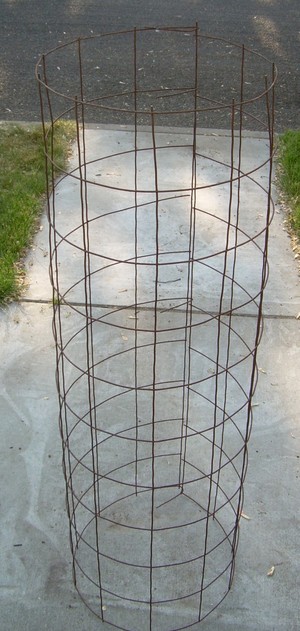Vegetable gardens can take up a lot of space, especially when planting things like tomatoes, pole beans, peas, and squash. To make more efficient use of the existing space we had, our family built a series of wire cages that allow vegetables to grow up instead of out.
These tomato cages are made of welded wire that measure 60 inches high. They are ideal for any type of vegetable that requires a cage, and are strong enough to hold the weight of heavy plants such as squash or gourds. They are also long lasting and durable; the tomato cages shown were made 16 years ago and are holding up as well as the day they were made. These cages do not need to be brought inside during the winter, but can be stored in the garden plot while not in use.
To make these tomato cages, all you need is a roll of welded wire, yard stick or measure tape, and a strong wire cutters.
Welded wire comes in an assortment of widths and grid sizes. The tomato cages shown were made of a wire with a 6 inch grid. This is large enough to allow room for the growing branches of a tomato plant or vine. Width sizes also vary, from 24 inches to 60 inches. We felt that the 60 inch width would be better suited for our tomatoes.
We had purchased our wire at a farm and livestock store, where it was referred to as a galvanized wire rolled panel fence. Some of our local home improvement stores also carry this product, calling it welded wire. The wire comes in 100 foot rolls and weighs approximately 208 pounds.
One internet resource I found (www.stockyardsupply.com) prices the roll at $144.90. This may seem a little pricey, however, a roll can make 15 cages which brings the price to approximately $10 per tomato cage. We split the cost with another family since 8 tomato cages was all we needed for our garden.
How to make the tomato cages
Step one:
To make the tomato cages, measure 6.5 feet and make your first cut along the bottom. This cut should be directly to the left of the next “grid”. You will ended up with an unattached 6 inch length of wire which will eventually be bent over to create a loop (see picture #2). Your next cut should be at the 6 foot mark, directly to the right of the grid. The third cut will be again at the 6.5 foot mark. Continue cutting in alternating fashion until you have reached the top. When you have completed cutting the wire, you should have 6 unattached lengths of 6 inch wire that will be bent to form the cage closures.
Step two:
Once the wire has been cut, pull the two ends together. You may need a helper (picture #3)
Step three:
Using a pair of pliers, bend the unattached lengths of wire to hold the two cage ends in place (picture #4 and #5). Continue until all the unattached wire pieces have been bent into loops. Make certain they are bent back far enough to prevent clothes from being snagged while walking through the garden.
Your tomato cage is now complete! The cages will have to be staked to prevent them from tipping as the plant grows, standard plastic tent stakes work quite well. We just drive the stakes all the way into the ground, catching the base of the wire cage in the “loop” of the stake. Two or three stakes are enough to keep even the heaviest tomato plant from falling over.


